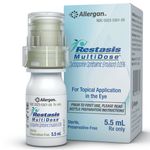MAR 02, 2018
By Keng Jin Lee and Anni Griswold
Comprehensive Ophthalmology, Cornea/External Disease, Neuro-Ophthalmology/Orbit
A weekly roundup of ophthalmic news from around the web.
 Allergan's deal with a Native American tribe to shelter Restasis’ patents has hit a roadblock. In September, Allergan sold the patents for its top-selling dry eye drug (cyclosporine ophthalmic emulsion 0.5%) to the Saint Regis Mohawk tribe to block generic competition. The tribe motioned to dismiss other companies’ patent challenges on the basis of sovereign immunity. But the U.S. Patent Trial and Appeal Board ruled that tribal immunity doesn't apply to inter partes reviews—so the charges will stand. STAT News
Allergan's deal with a Native American tribe to shelter Restasis’ patents has hit a roadblock. In September, Allergan sold the patents for its top-selling dry eye drug (cyclosporine ophthalmic emulsion 0.5%) to the Saint Regis Mohawk tribe to block generic competition. The tribe motioned to dismiss other companies’ patent challenges on the basis of sovereign immunity. But the U.S. Patent Trial and Appeal Board ruled that tribal immunity doesn't apply to inter partes reviews—so the charges will stand. STAT News
Indiana could become the second state after Oklahoma to ban scleral tattoos, a dangerous practice that could lead to permanent vision loss and even enucleation. A committee on Monday unanimously backed the proposal, which some called "the grossest bill of the session.” If approved by the Indiana House, tattoo artists could be fined up to $10,000 per violation. San Francisco Chronicle
“Am I going blind?” a New York Times journalist asks after waking up one morning with sudden vision loss in his right eye. In this powerful essay, he recounts how his life changed after experiencing an “eye stroke,” or nonarteritic anterior ischemic optic neuropathy. New York Times
Human tears may hold the earliest signs of Parkinson’s disease. A preliminary study reveals tell-tale differences in the protein content of tears from Parkinson’s patients versus healthy controls. If the findings pan out in larger studies, scientists hope tears may be an inexpensive, noninvasive way to screen for the condition. Independent
Apellis Pharmaceuticals reported positive data from its conjugated peptide candidate (APL-2) for geographic atrophy (GA). During the 6-months of post-treatment monitoring, GA lesions in the previously treated group grew at a similar rate to sham. The latest data confirms that the effect observed at 12 months—a 20% decrease in GA growth in APL-2 patients compared with sham—was the result of the biological activity of APL-2. A phase 3 trial is slated to begin in the second half of this year. Apellis Pharmaceuticals